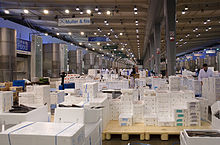Rungis wholesale market
The Rungis wholesale market (French Marché d'intérêt national de Rungis ) is the wholesale market in Paris and the largest in the world. It is located around 13 kilometers south of the city center in the towns of Rungis and Chevilly-Larue in the Île de France, a few kilometers north of Paris-Orly Airport . The operator is a public company ( marché d'intérêt national - MIN), which is operated by a state service provider Société d'économie mixte d'aménagement et de gestion du marché d'intérêt national de la région parisienne (SEMMARIS) société anonyme.
history
President Charles de Gaulle decided in 1960 that the 12 hectare Parisian wholesale market should move from the Quartier des Halles in the 1st arrondissement to the periphery. Construction work began in 1964 and lasted until 1969. On March 3, 1969, the great dealers' move took place. The planning and construction of Rungis was one of the largest urban development projects in France in the second half of the 20th century and was therefore also known as the move of the century ( Le déménagement du siècle ). In 1973 the Paris meat market, which had been located at La Villette with its slaughterhouses since 1950 , also moved to Rungis.
One of the first German importers was the restaurateur Karl-Heinz Wolf with his Rungis Express . Rungis increasingly developed into an important trading center for the upscale gastronomy of Europe. In 1975, for example, the “New Cooks” interest group was formed in Munich. Their primary goal was "unconditional quality and freshness". To this end, the founding members Eckart Witzigmann , Otto Koch and Hans-Peter Wodarz organized car pools to the market halls of Rungis.
Today (2019) thousands of tons of food arrive in the market halls every day, for example fish and shellfish from Brittany, meat from the Limousin and fruit and vegetables from southern France and Spain. For decades, a freight train ran from Perpignan to the Rungis wholesale market once or twice a day . In the summer of 2019, however, the state-owned railway company SNCF stopped this; since then the goods have been transported by around 20,000 trucks. Elisabeth Borne , Environment Minister in the Philippe II cabinet , wants to reactivate the freight train.
Data
The wholesale market has nine halls for vegetables, seven for meat, five for milk and cheese, one for fish and seafood and one hall for cut flowers.
The market covers 234 hectares. Thus the total area is larger than the Principality of Monaco. 30,000 employees and buyers and 24,000 vehicles drive to it every day. There is its own freight yard.
1,200 companies operate here, 520 of them wholesalers; the turnover in the 2013 financial year was 7.3 billion euros.
There are 23 restaurants and brasseries on the premises .
literature
- Olivier Bauer, Olivier Chartier: Au coeur de Rungis. With photos by Gilles Leimdorfer, Gallimard, Paris 2015, ISBN 978-2-74-243898-3 .
Films (selection)
- That's Paris . Feature film, France, 2008, 130 min., Written and directed by Cédric Klapisch , summary ( memento of September 26, 2016 in the Internet Archive ) by Das Erste .
- Travel for connoisseurs. France: Paris - Rungis wholesale market. (OT: Escapade gourmande. Le marché de Rungis. ) Documentary, Belgium, 2010, 25:40 min., Moderation: Guy Lemaire, director: Catherine Haxhe, production: Unicap Télévision, RTBF , series: Travel for connoisseurs (OT: Escapade gourmande ), German first broadcast: November 14, 2013 on arte, table of contents by ARD , online video .
- A load of delicatessen from Paris. Documentary, Germany, 2011, 14 min., Script and director: Stefan Weisse, production: WDR , series: Hier und heute , first broadcast: December 30, 2013 on WDR television , synopsis by ARD .
- Rungis - The largest food market in the world. Documentary, Germany, 2013, 41:18 min., Book: Brigita Zelic, camera: Alexander Maßhold, production: Weltenangler, n-tv , first broadcast: December 18, 2013 on n-tv, synopsis by Hörzu .
Web links
- RungisInternational.com (French, partly English)
- Information from the Paris Tourist Office on the visit (German)
- Bookings for groups of 20 people or more. In: visiterungis.com (French)
- How the ghost train from Rungis is being replaced by 20,000 trucks , Handelsblatt, October 5, 2019
- New "belly of Paris". The world's largest fresh market turns 40. In: n-tv , March 26, 2009.
- Video: The largest market in the world. Groceries from Rungis. In: N24 , July 13, 2015, 14:33 min.
Individual evidence
- ^ The role and tasks of SEMMARIS. SEMMARIS, accessed July 15, 2020 .
- ↑ Rungis 1969 - 2014. Chap. Le déménagement du siècle. In: La France à Rungis , 2014, accessed on September 27, 2016.
- ↑ Stefan Quante : Gourmet pioneer Karl-Heinz Wolf . ( Memento of February 17, 2006 in the Internet Archive ). In: WDR , August 14, 2004.
- ↑ Clark Parkin: Otto Koch and his strange cooking comeback. In: Die Welt , September 26, 2012.
- ↑ handelsblatt.com October 5, 2019, Thomas Hanke: How the Rungis ghost train is being replaced by 20,000 trucks
- ↑ www.bfmtv.com October 4, 2019: Perpignan-Rungis: le gouvernement dit travailler pour un redémarrage de la ligne en novembre
- ↑ Martina Meister: The Rungis wholesale market. Paris goes through the stomach. In: Tagesspiegel , April 15, 2011, accessed December 30, 2013.
- ↑ Self -presentation by Rungis, p. 5. ( Memento of the original from June 6, 2012 in the Internet Archive ) Info: The archive link was automatically inserted and not yet checked. Please check the original and archive link according to the instructions and then remove this notice. (PDF, 11.7 MB), French, accessed on December 30, 2013.
- ↑ Rob Kieffer: Mutton foot for breakfast. In: Die Zeit , No. 12, March 16, 2006.
Coordinates: 48 ° 45 ′ 35 ″ N , 2 ° 21 ′ 13 ″ E


